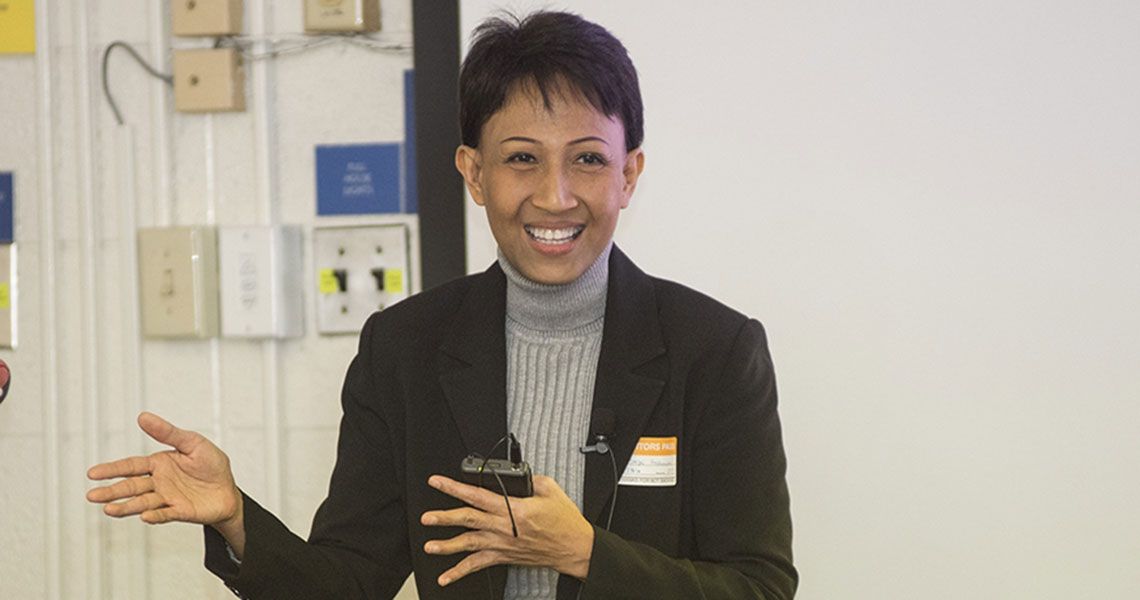It was designed to be a conversation explained Pimjai Sudsawad, Sc.D., knowledge translation program coordinator with the National Institute on Disability, Independent Living, and Rehabilitation Research (NIDILRR), U.S. Department of Health and Human Services, and Mary Corcoran, Ph.D., associate dean for faculty development for health sciences and professor of clinical research and leadership at the GW School of Medicine and Health Sciences (SMHS).
“I think that this represents a shift in thinking,” Sudsawad said of her lecture, “Knowledge Translation: The What, the Why, and the How,” which she presented as part of the Announcements of SMHS’ Ph.D. program in Translational Health Sciences. “I named this presentation ‘conversation’ for a reason because I actually want it to be that we’re talking together, we’re exploring ideas together, and see where we can go from there.”
As she explained, the concept of “bench to bedside,” translating research from the lab to a real-world application in the hospital or clinic, requires an understanding of “knowledge translation.” According to Sudsawad, knowledge translation — which can have multiple definitions, depending on the source — boils down to two meanings at NIDILRR: It’s a process ensuring that new knowledge and products will ultimately be used to improve the lives of individuals with disabilities and further their participation in society; and it’s built upon and sustained by ongoing interactions, partnerships, and collaborations among various stakeholders.
The key, Sudsawad said, is relevance. “It’s not just about creating knowledge,” she said. “We’re not going to be an organization that will just be concerned about producing rigorous research; we also want to be sure that we’re producing relevant [research] that could eventually lead to [better] outcomes.”
Knowledge translation, she added, is a process, not an event, that incorporates knowledge creation (“Can it be done in such a way to be used in a real-life setting?” Sudsawad asked), dissemination, use or implementation, and an evaluation of outcomes or impact. “That is the most important thing,” Sudsawad said. “You can’t sell something that’s not useful, period.”
Knowledge translation, she continued, is underpinned by effective exchanges, particularly as the process tends to be interactive and interdisciplinary. “You have to talk to people,” she said.
For Corcoran, Sudsawad’s presentation, which also included aspects of NIDILRR’s support strategies for knowledge translation (funding for knowledge translation centers, increasing public awareness of available knowledge and resources, and consistent communication with stakeholders, among others), tapped into SMHS’ educational movement toward translational health sciences.
“[GW initiated this presentation] in the growing recognition of the importance of the concepts of knowledge translation and some of the related concepts of translational research, translational science, implementation science, technology transfer, knowledge transfusion, and other types of words that people are using to talk about moving discoveries into widespread practical application,” Corcoran said.
The Ph.D. in Translational Health Sciences program, she explained, focuses on a foundation of collaboration science, with translational research, implementation science, and innovation in practice and research at its core. Students complete 54 credits beyond a master’s degree and concentrate on three main areas: professional health care education, health care practice, and translational research. They must also complete two comprehensive examinations, a proposal defense, and a defended dissertation. The program’s first cohort will begin classes in the fall of 2016.
Advisors, mentors, and a community of scholars play an important role for students, Corcoran added. In an effort to spur conversation and create a network, the program has included an online sign-up sheet for those interested in remaining informed about how they can participate in the education of doctoral students.
Corcoran’s remarks and Sudsawad’s presentation, co-sponsored by the SMHS Office of the Vice President for Research, also featured Robert Miller, Ph.D., Vivian Gill Distinguished Research Professor, senior associate dean for research, and professor of anatomy and regenerative biology at SMHS, and Jennifer Wisdom, Ph.D., M.P.H., associate vice president for research at SMHS. Wisdom discussed ongoing research at GW, both in and outside of medicine, while Miller reflected on Sudsawad’s lecture.
“As we move forward in our translational research, we have the opportunity to actually make a difference in the community and in community health,” he said.
Learn more about the Ph.D. in Translational Health Sciences program.



